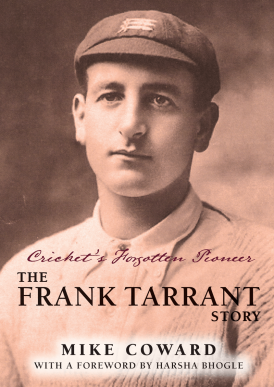Cricket’s Forgotten Pioneer: The Frank Tarrant Story
Martin Chandler |Published: 2020
Pages: 104
Author: Coward, Mike
Publisher: The Cricket Publishing Company
Rating: 5 stars

Mike Coward has been writing about cricket since, I believe, 1963, and he has been doing so to an exceptionally high standard. There have been some books along the way, and indeed the notes on the inside of the dust jacket of Cricket’s Forgotten Pioneer: The Frank Tarrant Story tell me there have been a dozen. I have made a mental note to try to pick up a few more, but those I have read are, without exception, well worth reading. As far as I am aware Coward has not however, prior to this one, written a biography. That he has not done so is a great shame as this fascinating account of an unusual cricketing life is right up there with the very best of the genre.
The inevitable first question, given that the uninitiated will look in vain for Tarrant’s name in a who’s who of Test cricketers, is who was he? The answer to that one is that he was a very fine Australian all-rounder, a batsman and orthodox left arm spinner, who chose to throw in his lot with Middlesex for whom he achieved the very considerable feat of eight consecutive doubles between 1907 and 1914. Had circumstances permitted him a career of more than ten English summers who knows what all-round records he may have set. As it is only Wilfred Rhodes, George Hirst, Vallance Jupp and Ewart Astill, all with much longer careers, did the double more than eight times.
Tarrant was certainly a good enough cricketer to have played for either England or Australia, but qualification rules worked against him and the Great War ended his career in England at 33. A shrewd man Tarrant had made important connections, particularly with Ranji, and through him other Indian royal houses, and in 1915 he visited India for the first time.
The greater part of Cricket’s Forgotten Pioneer: The Frank Tarrant Story is concerned with India. Tarrant played a huge role in the development of the game in the country, assisting with the preparation of the Indian sides that toured England in 1932 and 1936. He played a significant role in the first Test tour of India, by Douglas Jardine’s England side in 1933/34 during which, like so many others, he had a very public falling out with ‘The Iron Duke’.
The most interesting part of the Tarrant story, perhaps because it is the least known, is his role in the setting up of the tour of India by an Australian side in 1935/36. The backstage machinations of what, given the financial backing available to Tarrant from the Maharajah of Patiala, should have been a relatively straightforward exercise in fact proved to be extraordinarily complex.
There are a number of reasons why Coward’s book works so well. One is the length of time that he has been pondering it and taking an interest in his subject. Frank Tarrant died in 1951, so there is no one alive now who could possibly have known him well, but when Coward embarked on his career there were plenty of first hand tales to be heard, and Coward has doubtless spent many hours in the past discussing his subject with people who did know him.
Further assistance was derived from material available in newspapers, magazines and other printed media. Tarrant was not backward in coming forward when promoting himself. Above all Coward has clearly come to understand over the years what made Tarrant tick, and his account of his life is an authoritative one.
The book is not a long one, something which it could easily have been had Coward chosen to go down the route that so many biographers do and given a match by match account of the cricket that Tarrant played. There were as many 33 centuries, four of them doubles. Tarrant took ten wickets in an innings once, nine on a further seven occasions amongst a total of 133 five-fers and 38 ten wicket match hauls. He played and succeeded against the greatest batsman and bowlers of the Golden Age, but the reality is his finest performances came in the County Championship and, very sensibly in the circumstances, there are none of the match reports and commentaries that often slow biographies down, other than a brief chapter at the close of the book where Coward takes a quick look at a few of Tarrant’s most celebrated efforts. I am not going to suggest that all biographies of cricketers should take a similar approach, but that less really can be more is something that all who aspire to writing the life of a cricketer should bear in mind.
The superb narrative of Cricket’s Forgotten Pioneer: The Frank Tarrant Story is, I have to say, well worth five stars in any event, but there is another factor at work here. The book itself is a stunner and The Cricket Publishing Company are to be congratulated on a delightful production. It is printed on high quality paper, the rare and unusual photographs are superbly reproduced and, to supplement that closing chapter, there is a thorough and extremely well set out statistical appendix. At the moment the book is available only in the cloth bound and jacketed version that I have seen but, I do know, for those with boundless patience, that there is to be a short run of a signed leather bound edition to follow – it won’t be cheap, but is guaranteed to be a thing of beauty.






Leave a comment